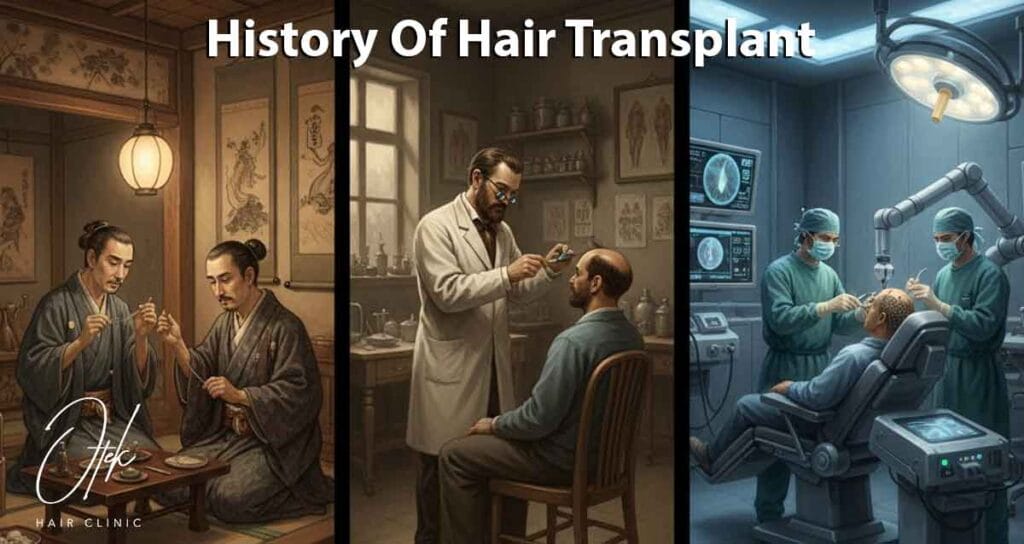According to known sources, the first hair transplant procedure was performed by a medical student and teacher in Germany in 1822. Modern hair transplants date back to the 1930s. The basics of modern hair transplantation was discarded by Dr. Sasagawa (1930) and Dr. It Okuda (1939). Dr. Okuda has developed the hair transplant application known as the punch technique to transplant hair on scars and burn scars. Hair transplantation studies were left to the next generations since Dr. Okuda died in the 2nd World War.Dr. Tamura has done great jobs in 1943. It was transferred to the pubic region by means of grafts containing a single hair, with a method very similar to the techniques used today. The Western world could not learn about these developments in hair transplantation for a long time because at that time the Second World War had broken out.
The first transplant surgery for male pattern hair loss was performed by Dr. Norman Orentreich in New York in 1952. The foundations of today’s modern hair transplantation techniques were laid when it was discovered that the transplanted hair follicles grew longer in the studies carried out during this period. The medical community was initially hesitant about this. This technique was published in 1959. Dr. Orentreich tried to explain the basic principle of hair transplantation with the term “donor dominance”. According to Dr. Orentreich, the transplanted hair follicle showed the same characteristics as the donor area. Knowing this laid the foundation for many modern methods.
The idea of laser opening the holes where the grafts would be placed was put forward and implemented, with a different perspective in 1990. Although it is seen as a technological method in hair transplantation, it has not been demanded much due to the traces left by the laser on the skin and the weak appearance of the hair afterwards. Although laser is still on the agenda today, it is not used much.
Another technique called scalp reduction was used in the 1980s and 1990s. In the scalp technique, the skin in the balding area was removed and flaps were turned from the hairy area on the sides of the scalp to the balding area. However, this method was completely abandoned due to intense scar formation, unnatural hairstyles and especially the discovery of the FUT technique.
In 1984,much smaller mini-grafts (containing 1-2 hairs) were obtained from strips taken from the donor area, resulting in much better results. In this mini-micro-graft technique, larger grafts were placed in the center and micro-grafts were placed on the hair edges and front. This technique was accepted as the standard and used regularly for 20 years until the end of the 1990s. A different technique started to be used when we came to 1995. Stereo-microscopic graft dissection, called Follicular Unit Transplantation (FUT), has begun to be used in hair transplantation procedures. Although a much more natural image is obtained thanks to the FUT technique, it has been realized that it requires expertise since it is surgical in terms of application.
Although the FUT technique was initially very dubious, FUT became the “Gold Standard” for surgical hair transplantation in 2000, as the results were more natural. It was also very popular among patients because of its natural-looking results.
In 2002, the “follicular unit extraction” (FUE) technique, which is based on the direct extraction of follicular unit grafts from the donor area by Rassman and Bernstein, entered the literature. However, the popularity of the FUE technique was realized with the article written by Harris in 2005. Graft removal was thought to be more useful in this technique.
In 2007, however, Dr. Miquen G. Canales and Dr. Thanks to the work of David Berman, there have been developments in the robotic FUE hair transplant method.The basis of robotic hair transplantation is the FUE hair transplantation method. In robotic hair surgery, the procedure is performed by removing the hair follicles from the donor area by robots. The hair follicles collected by the robotic method are applied manually in the channels opened by the manual method.
Call Us Today for FREE Consultations
ASK A QUESTION

